Airbag Technology: Evolution and Future of Car Safety
VerifiedAdded on 2021/04/24
|9
|2185
|123
Report
AI Summary
This report delves into the intricacies of airbag technology, a crucial component of modern vehicle safety systems. It begins with an introduction to airbags as passive supplemental restraints designed to protect drivers and passengers during frontal impacts. The report then provides a detailed description of the airbag system, including its components like the airbag module, sensors, and monitoring systems, explaining how they work together to detect collisions and deploy the airbag rapidly. The report highlights the historical context of airbag development, discussing the motivations behind its invention and its widespread adoption due to its effectiveness in reducing fatalities and injuries in car crashes. It also addresses the evolution of airbag technology, improvements in the function, and the potential for future advancements, such as smart release systems and the integration of pre-impact sensors. The report concludes by emphasizing the importance of airbag technology in the current automotive landscape and its continued relevance as a dominant safety feature, while also acknowledging areas where further innovation can enhance its effectiveness.
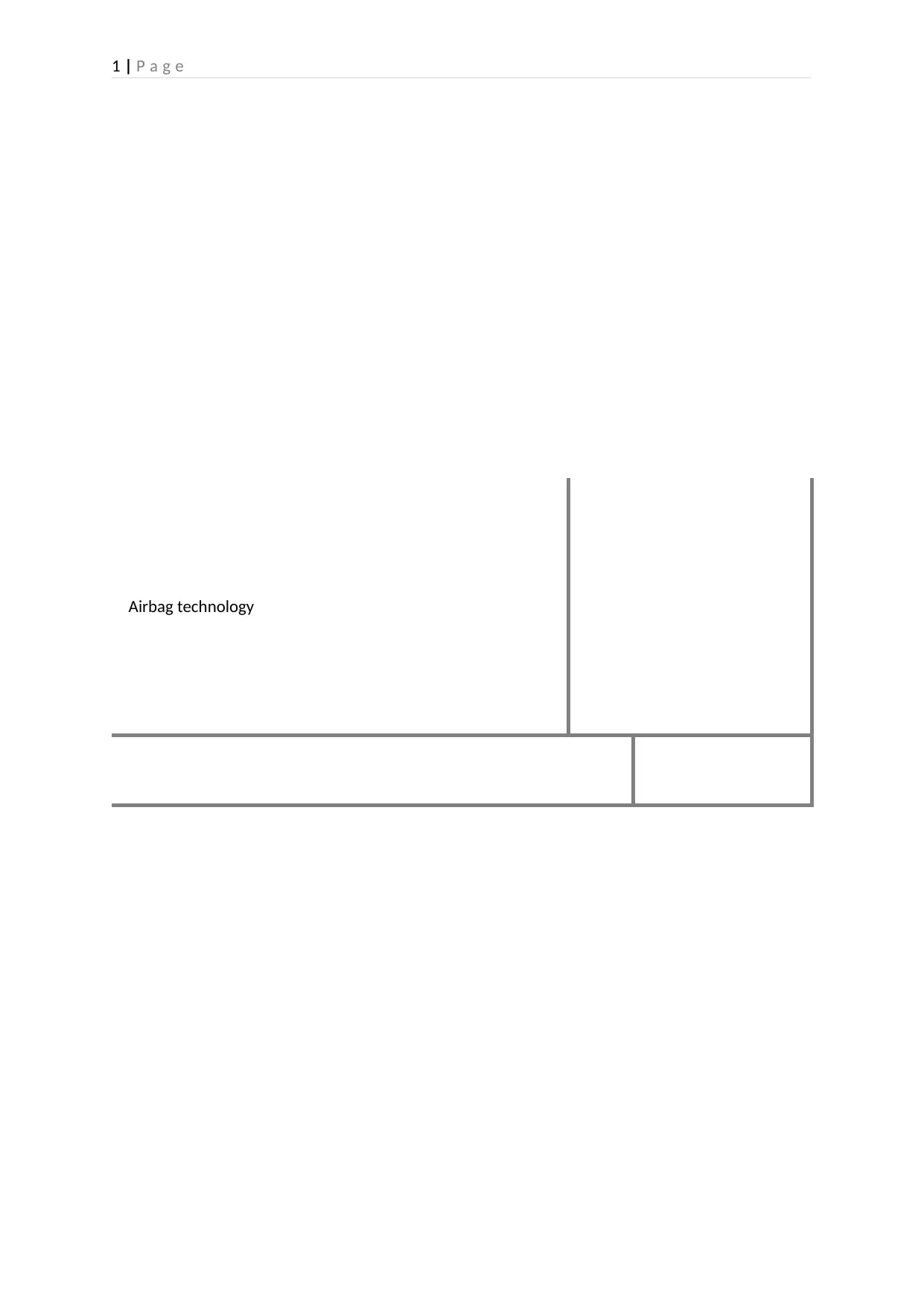
1 | P a g e
Airbag technology
Airbag technology
Paraphrase This Document
Need a fresh take? Get an instant paraphrase of this document with our AI Paraphraser

2 | P a g e
Table of Contents
Introduction...........................................................................................................................................2
Description............................................................................................................................................2
Conclusion.............................................................................................................................................6
References.............................................................................................................................................7
Table of Contents
Introduction...........................................................................................................................................2
Description............................................................................................................................................2
Conclusion.............................................................................................................................................6
References.............................................................................................................................................7
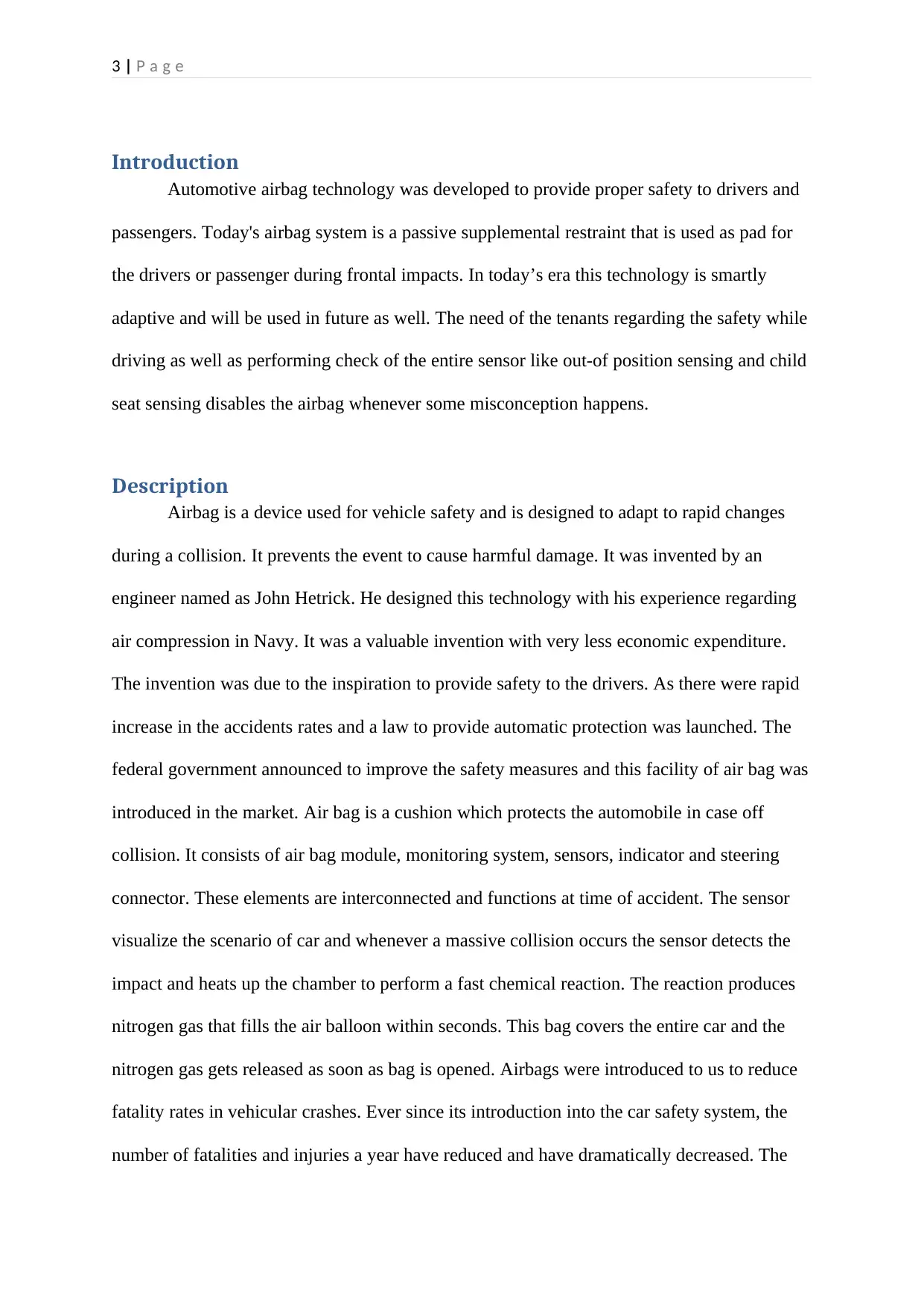
3 | P a g e
Introduction
Automotive airbag technology was developed to provide proper safety to drivers and
passengers. Today's airbag system is a passive supplemental restraint that is used as pad for
the drivers or passenger during frontal impacts. In today’s era this technology is smartly
adaptive and will be used in future as well. The need of the tenants regarding the safety while
driving as well as performing check of the entire sensor like out-of position sensing and child
seat sensing disables the airbag whenever some misconception happens.
Description
Airbag is a device used for vehicle safety and is designed to adapt to rapid changes
during a collision. It prevents the event to cause harmful damage. It was invented by an
engineer named as John Hetrick. He designed this technology with his experience regarding
air compression in Navy. It was a valuable invention with very less economic expenditure.
The invention was due to the inspiration to provide safety to the drivers. As there were rapid
increase in the accidents rates and a law to provide automatic protection was launched. The
federal government announced to improve the safety measures and this facility of air bag was
introduced in the market. Air bag is a cushion which protects the automobile in case off
collision. It consists of air bag module, monitoring system, sensors, indicator and steering
connector. These elements are interconnected and functions at time of accident. The sensor
visualize the scenario of car and whenever a massive collision occurs the sensor detects the
impact and heats up the chamber to perform a fast chemical reaction. The reaction produces
nitrogen gas that fills the air balloon within seconds. This bag covers the entire car and the
nitrogen gas gets released as soon as bag is opened. Airbags were introduced to us to reduce
fatality rates in vehicular crashes. Ever since its introduction into the car safety system, the
number of fatalities and injuries a year have reduced and have dramatically decreased. The
Introduction
Automotive airbag technology was developed to provide proper safety to drivers and
passengers. Today's airbag system is a passive supplemental restraint that is used as pad for
the drivers or passenger during frontal impacts. In today’s era this technology is smartly
adaptive and will be used in future as well. The need of the tenants regarding the safety while
driving as well as performing check of the entire sensor like out-of position sensing and child
seat sensing disables the airbag whenever some misconception happens.
Description
Airbag is a device used for vehicle safety and is designed to adapt to rapid changes
during a collision. It prevents the event to cause harmful damage. It was invented by an
engineer named as John Hetrick. He designed this technology with his experience regarding
air compression in Navy. It was a valuable invention with very less economic expenditure.
The invention was due to the inspiration to provide safety to the drivers. As there were rapid
increase in the accidents rates and a law to provide automatic protection was launched. The
federal government announced to improve the safety measures and this facility of air bag was
introduced in the market. Air bag is a cushion which protects the automobile in case off
collision. It consists of air bag module, monitoring system, sensors, indicator and steering
connector. These elements are interconnected and functions at time of accident. The sensor
visualize the scenario of car and whenever a massive collision occurs the sensor detects the
impact and heats up the chamber to perform a fast chemical reaction. The reaction produces
nitrogen gas that fills the air balloon within seconds. This bag covers the entire car and the
nitrogen gas gets released as soon as bag is opened. Airbags were introduced to us to reduce
fatality rates in vehicular crashes. Ever since its introduction into the car safety system, the
number of fatalities and injuries a year have reduced and have dramatically decreased. The
⊘ This is a preview!⊘
Do you want full access?
Subscribe today to unlock all pages.

Trusted by 1+ million students worldwide
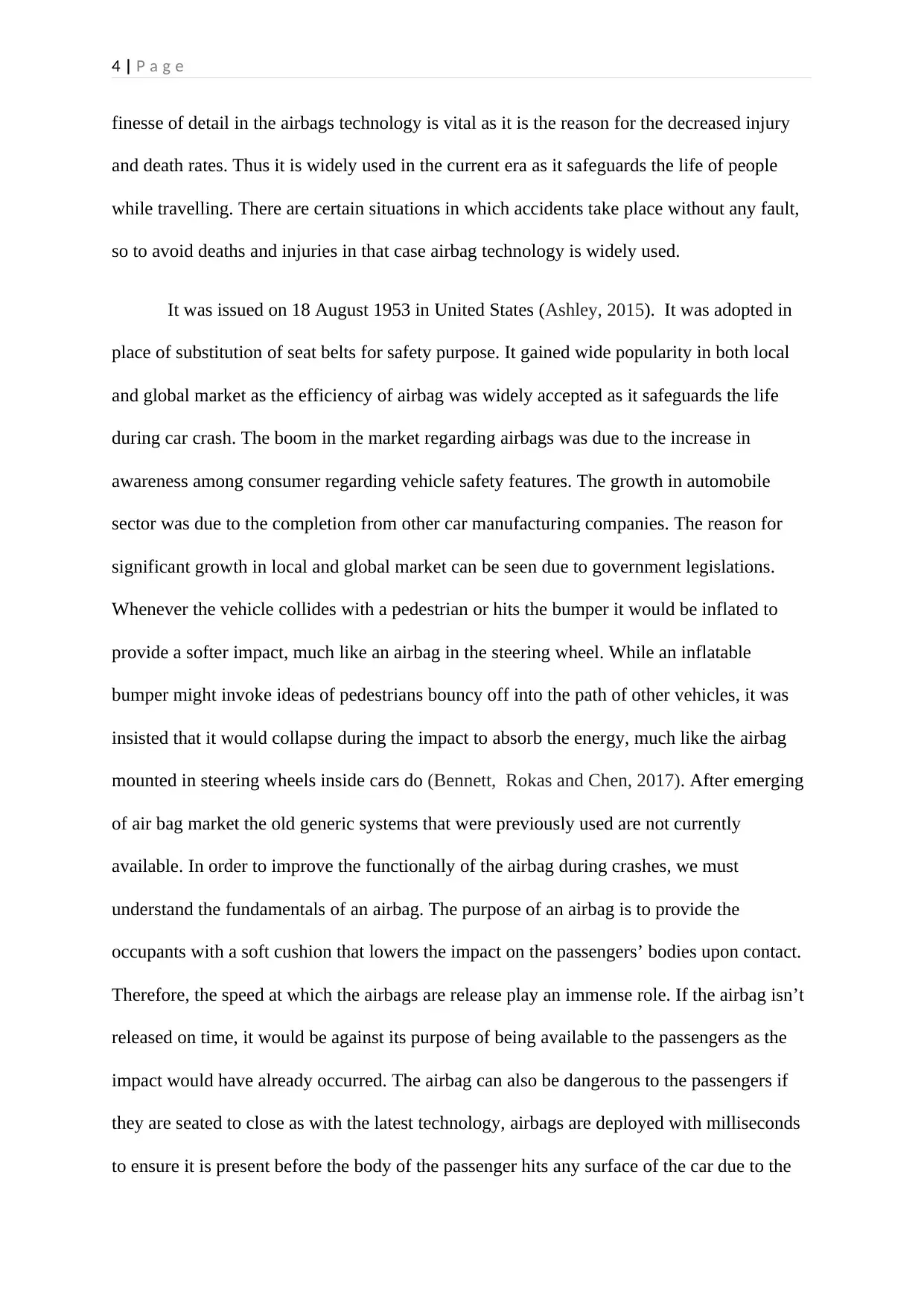
4 | P a g e
finesse of detail in the airbags technology is vital as it is the reason for the decreased injury
and death rates. Thus it is widely used in the current era as it safeguards the life of people
while travelling. There are certain situations in which accidents take place without any fault,
so to avoid deaths and injuries in that case airbag technology is widely used.
It was issued on 18 August 1953 in United States (Ashley, 2015). It was adopted in
place of substitution of seat belts for safety purpose. It gained wide popularity in both local
and global market as the efficiency of airbag was widely accepted as it safeguards the life
during car crash. The boom in the market regarding airbags was due to the increase in
awareness among consumer regarding vehicle safety features. The growth in automobile
sector was due to the completion from other car manufacturing companies. The reason for
significant growth in local and global market can be seen due to government legislations.
Whenever the vehicle collides with a pedestrian or hits the bumper it would be inflated to
provide a softer impact, much like an airbag in the steering wheel. While an inflatable
bumper might invoke ideas of pedestrians bouncy off into the path of other vehicles, it was
insisted that it would collapse during the impact to absorb the energy, much like the airbag
mounted in steering wheels inside cars do (Bennett, Rokas and Chen, 2017). After emerging
of air bag market the old generic systems that were previously used are not currently
available. In order to improve the functionally of the airbag during crashes, we must
understand the fundamentals of an airbag. The purpose of an airbag is to provide the
occupants with a soft cushion that lowers the impact on the passengers’ bodies upon contact.
Therefore, the speed at which the airbags are release play an immense role. If the airbag isn’t
released on time, it would be against its purpose of being available to the passengers as the
impact would have already occurred. The airbag can also be dangerous to the passengers if
they are seated to close as with the latest technology, airbags are deployed with milliseconds
to ensure it is present before the body of the passenger hits any surface of the car due to the
finesse of detail in the airbags technology is vital as it is the reason for the decreased injury
and death rates. Thus it is widely used in the current era as it safeguards the life of people
while travelling. There are certain situations in which accidents take place without any fault,
so to avoid deaths and injuries in that case airbag technology is widely used.
It was issued on 18 August 1953 in United States (Ashley, 2015). It was adopted in
place of substitution of seat belts for safety purpose. It gained wide popularity in both local
and global market as the efficiency of airbag was widely accepted as it safeguards the life
during car crash. The boom in the market regarding airbags was due to the increase in
awareness among consumer regarding vehicle safety features. The growth in automobile
sector was due to the completion from other car manufacturing companies. The reason for
significant growth in local and global market can be seen due to government legislations.
Whenever the vehicle collides with a pedestrian or hits the bumper it would be inflated to
provide a softer impact, much like an airbag in the steering wheel. While an inflatable
bumper might invoke ideas of pedestrians bouncy off into the path of other vehicles, it was
insisted that it would collapse during the impact to absorb the energy, much like the airbag
mounted in steering wheels inside cars do (Bennett, Rokas and Chen, 2017). After emerging
of air bag market the old generic systems that were previously used are not currently
available. In order to improve the functionally of the airbag during crashes, we must
understand the fundamentals of an airbag. The purpose of an airbag is to provide the
occupants with a soft cushion that lowers the impact on the passengers’ bodies upon contact.
Therefore, the speed at which the airbags are release play an immense role. If the airbag isn’t
released on time, it would be against its purpose of being available to the passengers as the
impact would have already occurred. The airbag can also be dangerous to the passengers if
they are seated to close as with the latest technology, airbags are deployed with milliseconds
to ensure it is present before the body of the passenger hits any surface of the car due to the
Paraphrase This Document
Need a fresh take? Get an instant paraphrase of this document with our AI Paraphraser
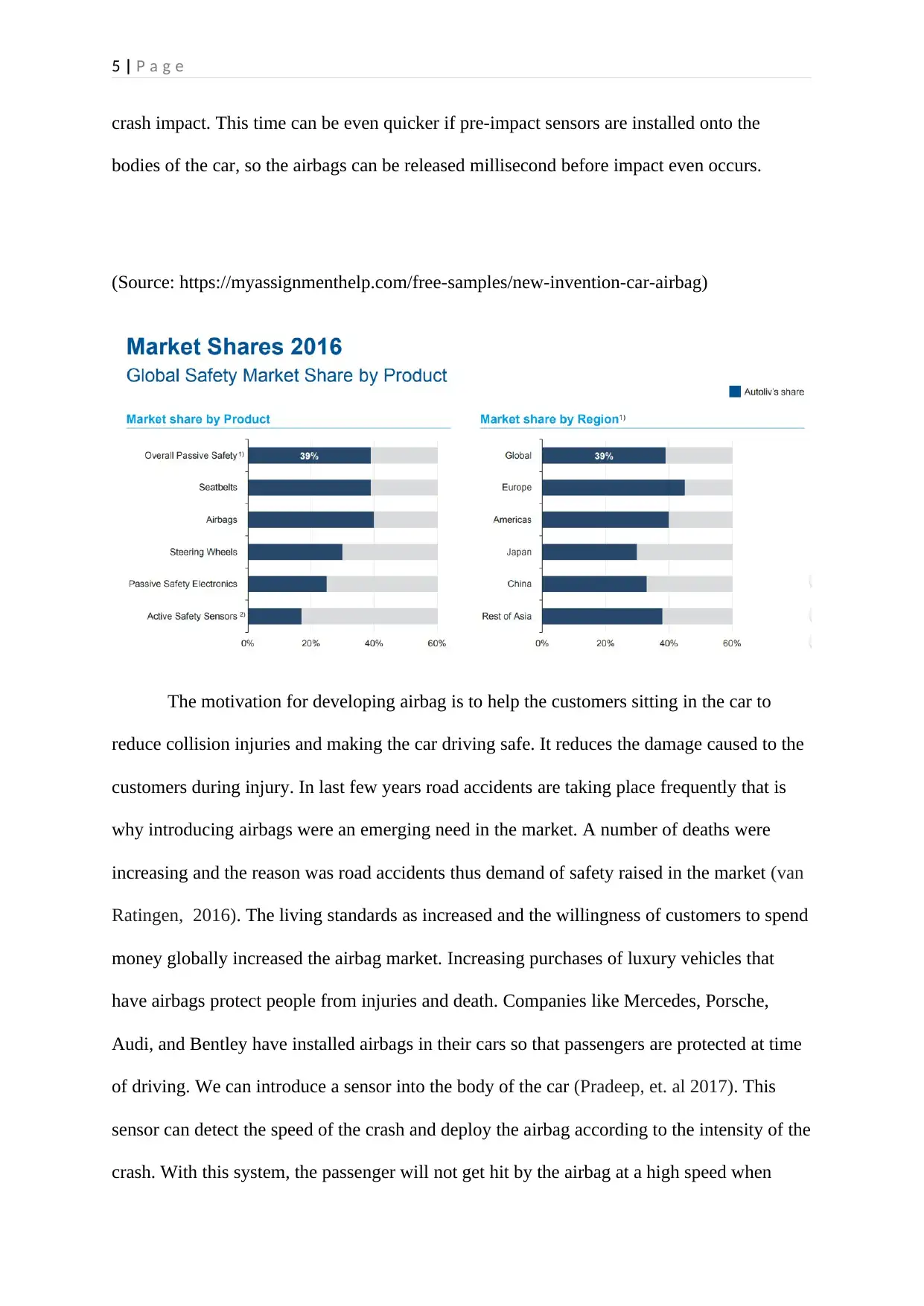
5 | P a g e
crash impact. This time can be even quicker if pre-impact sensors are installed onto the
bodies of the car, so the airbags can be released millisecond before impact even occurs.
(Source: https://myassignmenthelp.com/free-samples/new-invention-car-airbag)
The motivation for developing airbag is to help the customers sitting in the car to
reduce collision injuries and making the car driving safe. It reduces the damage caused to the
customers during injury. In last few years road accidents are taking place frequently that is
why introducing airbags were an emerging need in the market. A number of deaths were
increasing and the reason was road accidents thus demand of safety raised in the market (van
Ratingen, 2016). The living standards as increased and the willingness of customers to spend
money globally increased the airbag market. Increasing purchases of luxury vehicles that
have airbags protect people from injuries and death. Companies like Mercedes, Porsche,
Audi, and Bentley have installed airbags in their cars so that passengers are protected at time
of driving. We can introduce a sensor into the body of the car (Pradeep, et. al 2017). This
sensor can detect the speed of the crash and deploy the airbag according to the intensity of the
crash. With this system, the passenger will not get hit by the airbag at a high speed when
crash impact. This time can be even quicker if pre-impact sensors are installed onto the
bodies of the car, so the airbags can be released millisecond before impact even occurs.
(Source: https://myassignmenthelp.com/free-samples/new-invention-car-airbag)
The motivation for developing airbag is to help the customers sitting in the car to
reduce collision injuries and making the car driving safe. It reduces the damage caused to the
customers during injury. In last few years road accidents are taking place frequently that is
why introducing airbags were an emerging need in the market. A number of deaths were
increasing and the reason was road accidents thus demand of safety raised in the market (van
Ratingen, 2016). The living standards as increased and the willingness of customers to spend
money globally increased the airbag market. Increasing purchases of luxury vehicles that
have airbags protect people from injuries and death. Companies like Mercedes, Porsche,
Audi, and Bentley have installed airbags in their cars so that passengers are protected at time
of driving. We can introduce a sensor into the body of the car (Pradeep, et. al 2017). This
sensor can detect the speed of the crash and deploy the airbag according to the intensity of the
crash. With this system, the passenger will not get hit by the airbag at a high speed when
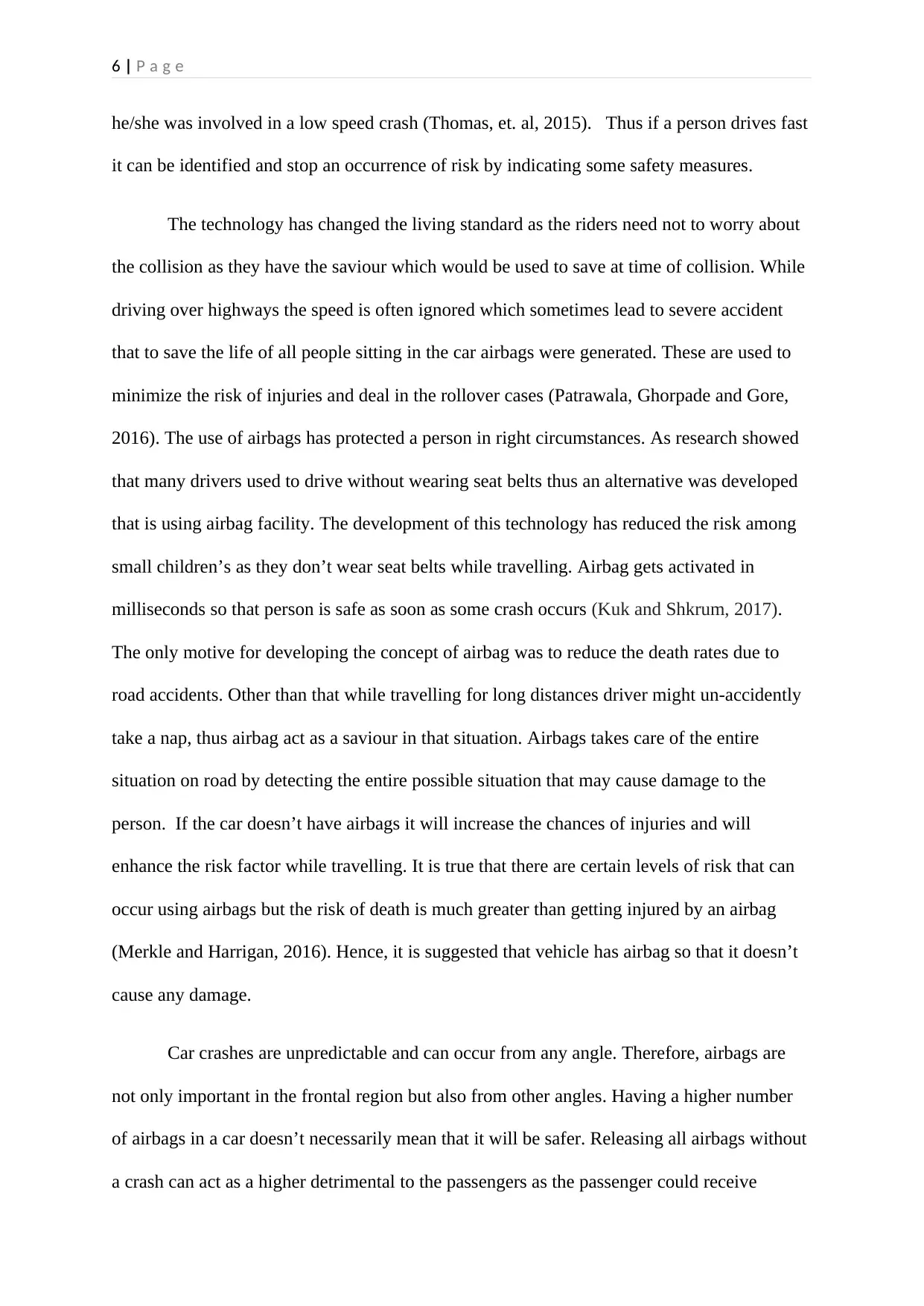
6 | P a g e
he/she was involved in a low speed crash (Thomas, et. al, 2015). Thus if a person drives fast
it can be identified and stop an occurrence of risk by indicating some safety measures.
The technology has changed the living standard as the riders need not to worry about
the collision as they have the saviour which would be used to save at time of collision. While
driving over highways the speed is often ignored which sometimes lead to severe accident
that to save the life of all people sitting in the car airbags were generated. These are used to
minimize the risk of injuries and deal in the rollover cases (Patrawala, Ghorpade and Gore,
2016). The use of airbags has protected a person in right circumstances. As research showed
that many drivers used to drive without wearing seat belts thus an alternative was developed
that is using airbag facility. The development of this technology has reduced the risk among
small children’s as they don’t wear seat belts while travelling. Airbag gets activated in
milliseconds so that person is safe as soon as some crash occurs (Kuk and Shkrum, 2017).
The only motive for developing the concept of airbag was to reduce the death rates due to
road accidents. Other than that while travelling for long distances driver might un-accidently
take a nap, thus airbag act as a saviour in that situation. Airbags takes care of the entire
situation on road by detecting the entire possible situation that may cause damage to the
person. If the car doesn’t have airbags it will increase the chances of injuries and will
enhance the risk factor while travelling. It is true that there are certain levels of risk that can
occur using airbags but the risk of death is much greater than getting injured by an airbag
(Merkle and Harrigan, 2016). Hence, it is suggested that vehicle has airbag so that it doesn’t
cause any damage.
Car crashes are unpredictable and can occur from any angle. Therefore, airbags are
not only important in the frontal region but also from other angles. Having a higher number
of airbags in a car doesn’t necessarily mean that it will be safer. Releasing all airbags without
a crash can act as a higher detrimental to the passengers as the passenger could receive
he/she was involved in a low speed crash (Thomas, et. al, 2015). Thus if a person drives fast
it can be identified and stop an occurrence of risk by indicating some safety measures.
The technology has changed the living standard as the riders need not to worry about
the collision as they have the saviour which would be used to save at time of collision. While
driving over highways the speed is often ignored which sometimes lead to severe accident
that to save the life of all people sitting in the car airbags were generated. These are used to
minimize the risk of injuries and deal in the rollover cases (Patrawala, Ghorpade and Gore,
2016). The use of airbags has protected a person in right circumstances. As research showed
that many drivers used to drive without wearing seat belts thus an alternative was developed
that is using airbag facility. The development of this technology has reduced the risk among
small children’s as they don’t wear seat belts while travelling. Airbag gets activated in
milliseconds so that person is safe as soon as some crash occurs (Kuk and Shkrum, 2017).
The only motive for developing the concept of airbag was to reduce the death rates due to
road accidents. Other than that while travelling for long distances driver might un-accidently
take a nap, thus airbag act as a saviour in that situation. Airbags takes care of the entire
situation on road by detecting the entire possible situation that may cause damage to the
person. If the car doesn’t have airbags it will increase the chances of injuries and will
enhance the risk factor while travelling. It is true that there are certain levels of risk that can
occur using airbags but the risk of death is much greater than getting injured by an airbag
(Merkle and Harrigan, 2016). Hence, it is suggested that vehicle has airbag so that it doesn’t
cause any damage.
Car crashes are unpredictable and can occur from any angle. Therefore, airbags are
not only important in the frontal region but also from other angles. Having a higher number
of airbags in a car doesn’t necessarily mean that it will be safer. Releasing all airbags without
a crash can act as a higher detrimental to the passengers as the passenger could receive
⊘ This is a preview!⊘
Do you want full access?
Subscribe today to unlock all pages.

Trusted by 1+ million students worldwide
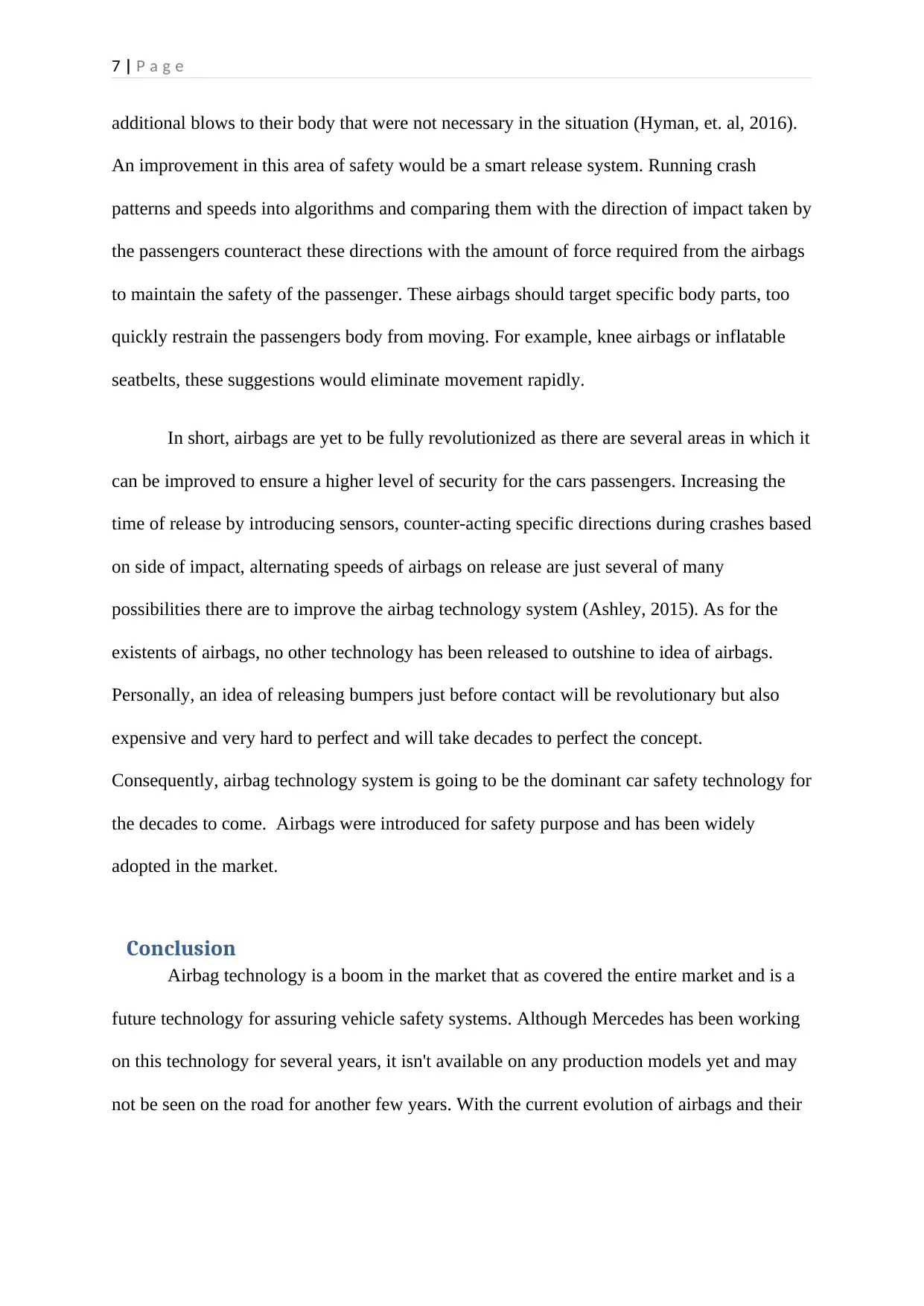
7 | P a g e
additional blows to their body that were not necessary in the situation (Hyman, et. al, 2016).
An improvement in this area of safety would be a smart release system. Running crash
patterns and speeds into algorithms and comparing them with the direction of impact taken by
the passengers counteract these directions with the amount of force required from the airbags
to maintain the safety of the passenger. These airbags should target specific body parts, too
quickly restrain the passengers body from moving. For example, knee airbags or inflatable
seatbelts, these suggestions would eliminate movement rapidly.
In short, airbags are yet to be fully revolutionized as there are several areas in which it
can be improved to ensure a higher level of security for the cars passengers. Increasing the
time of release by introducing sensors, counter-acting specific directions during crashes based
on side of impact, alternating speeds of airbags on release are just several of many
possibilities there are to improve the airbag technology system (Ashley, 2015). As for the
existents of airbags, no other technology has been released to outshine to idea of airbags.
Personally, an idea of releasing bumpers just before contact will be revolutionary but also
expensive and very hard to perfect and will take decades to perfect the concept.
Consequently, airbag technology system is going to be the dominant car safety technology for
the decades to come. Airbags were introduced for safety purpose and has been widely
adopted in the market.
Conclusion
Airbag technology is a boom in the market that as covered the entire market and is a
future technology for assuring vehicle safety systems. Although Mercedes has been working
on this technology for several years, it isn't available on any production models yet and may
not be seen on the road for another few years. With the current evolution of airbags and their
additional blows to their body that were not necessary in the situation (Hyman, et. al, 2016).
An improvement in this area of safety would be a smart release system. Running crash
patterns and speeds into algorithms and comparing them with the direction of impact taken by
the passengers counteract these directions with the amount of force required from the airbags
to maintain the safety of the passenger. These airbags should target specific body parts, too
quickly restrain the passengers body from moving. For example, knee airbags or inflatable
seatbelts, these suggestions would eliminate movement rapidly.
In short, airbags are yet to be fully revolutionized as there are several areas in which it
can be improved to ensure a higher level of security for the cars passengers. Increasing the
time of release by introducing sensors, counter-acting specific directions during crashes based
on side of impact, alternating speeds of airbags on release are just several of many
possibilities there are to improve the airbag technology system (Ashley, 2015). As for the
existents of airbags, no other technology has been released to outshine to idea of airbags.
Personally, an idea of releasing bumpers just before contact will be revolutionary but also
expensive and very hard to perfect and will take decades to perfect the concept.
Consequently, airbag technology system is going to be the dominant car safety technology for
the decades to come. Airbags were introduced for safety purpose and has been widely
adopted in the market.
Conclusion
Airbag technology is a boom in the market that as covered the entire market and is a
future technology for assuring vehicle safety systems. Although Mercedes has been working
on this technology for several years, it isn't available on any production models yet and may
not be seen on the road for another few years. With the current evolution of airbags and their
Paraphrase This Document
Need a fresh take? Get an instant paraphrase of this document with our AI Paraphraser
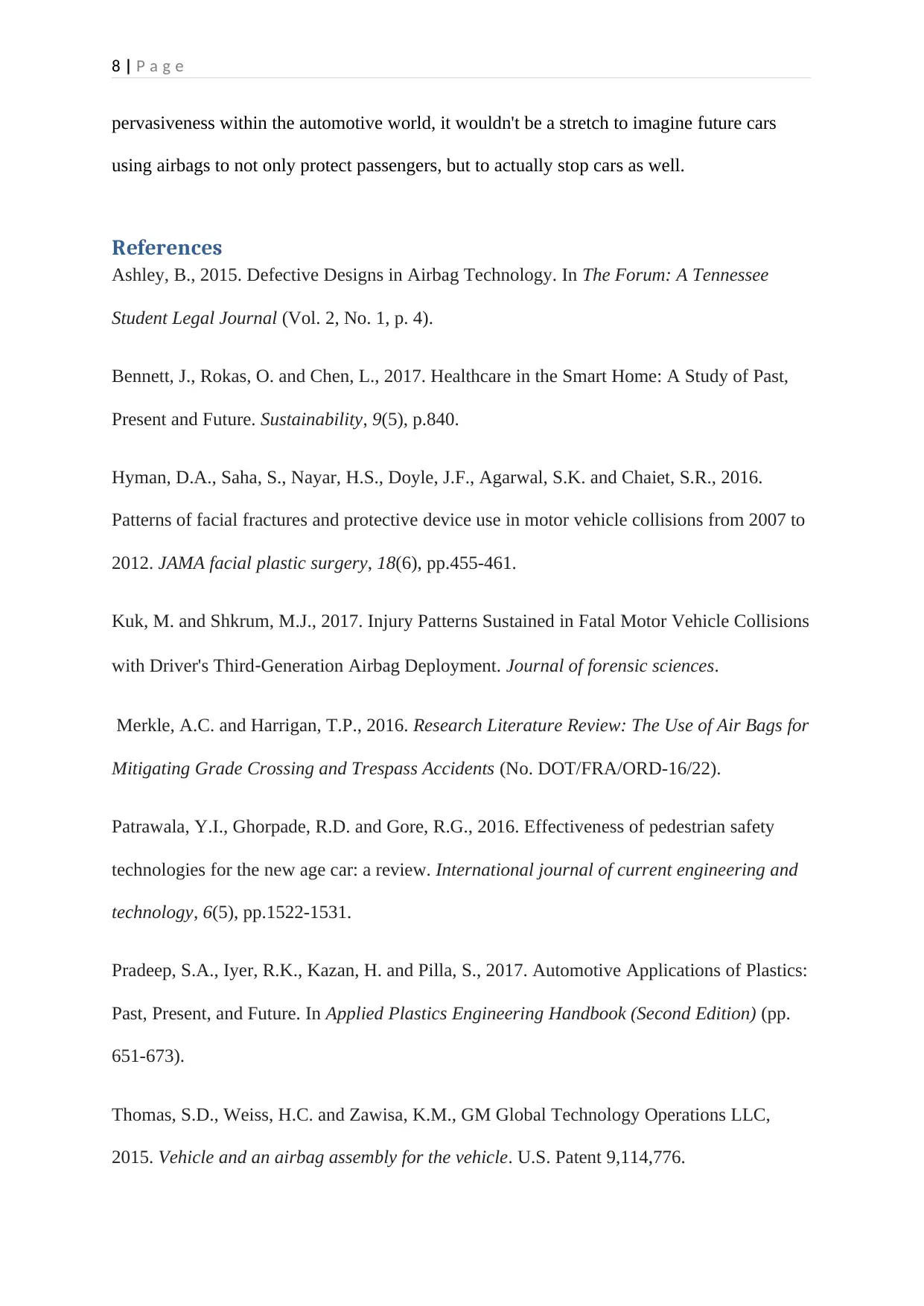
8 | P a g e
pervasiveness within the automotive world, it wouldn't be a stretch to imagine future cars
using airbags to not only protect passengers, but to actually stop cars as well.
References
Ashley, B., 2015. Defective Designs in Airbag Technology. In The Forum: A Tennessee
Student Legal Journal (Vol. 2, No. 1, p. 4).
Bennett, J., Rokas, O. and Chen, L., 2017. Healthcare in the Smart Home: A Study of Past,
Present and Future. Sustainability, 9(5), p.840.
Hyman, D.A., Saha, S., Nayar, H.S., Doyle, J.F., Agarwal, S.K. and Chaiet, S.R., 2016.
Patterns of facial fractures and protective device use in motor vehicle collisions from 2007 to
2012. JAMA facial plastic surgery, 18(6), pp.455-461.
Kuk, M. and Shkrum, M.J., 2017. Injury Patterns Sustained in Fatal Motor Vehicle Collisions
with Driver's Third‐Generation Airbag Deployment. Journal of forensic sciences.
Merkle, A.C. and Harrigan, T.P., 2016. Research Literature Review: The Use of Air Bags for
Mitigating Grade Crossing and Trespass Accidents (No. DOT/FRA/ORD-16/22).
Patrawala, Y.I., Ghorpade, R.D. and Gore, R.G., 2016. Effectiveness of pedestrian safety
technologies for the new age car: a review. International journal of current engineering and
technology, 6(5), pp.1522-1531.
Pradeep, S.A., Iyer, R.K., Kazan, H. and Pilla, S., 2017. Automotive Applications of Plastics:
Past, Present, and Future. In Applied Plastics Engineering Handbook (Second Edition) (pp.
651-673).
Thomas, S.D., Weiss, H.C. and Zawisa, K.M., GM Global Technology Operations LLC,
2015. Vehicle and an airbag assembly for the vehicle. U.S. Patent 9,114,776.
pervasiveness within the automotive world, it wouldn't be a stretch to imagine future cars
using airbags to not only protect passengers, but to actually stop cars as well.
References
Ashley, B., 2015. Defective Designs in Airbag Technology. In The Forum: A Tennessee
Student Legal Journal (Vol. 2, No. 1, p. 4).
Bennett, J., Rokas, O. and Chen, L., 2017. Healthcare in the Smart Home: A Study of Past,
Present and Future. Sustainability, 9(5), p.840.
Hyman, D.A., Saha, S., Nayar, H.S., Doyle, J.F., Agarwal, S.K. and Chaiet, S.R., 2016.
Patterns of facial fractures and protective device use in motor vehicle collisions from 2007 to
2012. JAMA facial plastic surgery, 18(6), pp.455-461.
Kuk, M. and Shkrum, M.J., 2017. Injury Patterns Sustained in Fatal Motor Vehicle Collisions
with Driver's Third‐Generation Airbag Deployment. Journal of forensic sciences.
Merkle, A.C. and Harrigan, T.P., 2016. Research Literature Review: The Use of Air Bags for
Mitigating Grade Crossing and Trespass Accidents (No. DOT/FRA/ORD-16/22).
Patrawala, Y.I., Ghorpade, R.D. and Gore, R.G., 2016. Effectiveness of pedestrian safety
technologies for the new age car: a review. International journal of current engineering and
technology, 6(5), pp.1522-1531.
Pradeep, S.A., Iyer, R.K., Kazan, H. and Pilla, S., 2017. Automotive Applications of Plastics:
Past, Present, and Future. In Applied Plastics Engineering Handbook (Second Edition) (pp.
651-673).
Thomas, S.D., Weiss, H.C. and Zawisa, K.M., GM Global Technology Operations LLC,
2015. Vehicle and an airbag assembly for the vehicle. U.S. Patent 9,114,776.

9 | P a g e
Van Ratingen, M.R., 2016. Saving Lives with Safer Cars: The Past, Present and Future of
Consumer Safety Ratings. In Proceedings of the IRCOBI Conference.
Van Ratingen, M.R., 2016. Saving Lives with Safer Cars: The Past, Present and Future of
Consumer Safety Ratings. In Proceedings of the IRCOBI Conference.
⊘ This is a preview!⊘
Do you want full access?
Subscribe today to unlock all pages.

Trusted by 1+ million students worldwide
1 out of 9
Your All-in-One AI-Powered Toolkit for Academic Success.
+13062052269
info@desklib.com
Available 24*7 on WhatsApp / Email
![[object Object]](/_next/static/media/star-bottom.7253800d.svg)
Unlock your academic potential
Copyright © 2020–2025 A2Z Services. All Rights Reserved. Developed and managed by ZUCOL.


